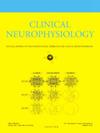顽固性癫痫患者多通道经颅直流电刺激后脑磁图的局部和网络变化。
IF 3.7
3区 医学
Q1 CLINICAL NEUROLOGY
引用次数: 0
摘要
目的:非侵入性神经调节技术,特别是经颅直流电刺激(tDCS),有望治疗耐药癫痫(DRE),尽管其疗效机制尚不清楚。本研究旨在(i)利用个性化的多通道协议和脑磁图(MEG)研究tDCS的神经生理机制,(ii)评估tDCS后大脑连接的变化,并将其与临床结果联系起来。方法:17例局灶性DRE患者在5天内接受了3个tDCS周期,每个周期由40分钟的刺激组成,目标是通过立体脑电图识别的癫痫发生区(EZ)。在会话前后进行MEG,以评估功能连通性(FC)和功率谱密度(PSD),在源水平(波束形成)估计。结果:14例患者中有5例癫痫发作频率降低50%。不同频带的PSD变化明显,反应者的FC减少,无反应者的连通性增加(结论:个性化多通道tDCS诱导与DRE癫痫发作减少相关的神经生理变化。意义:这些结果为tDCS对癫痫脑网络的影响提供了有价值的见解,为未来癫痫治疗的临床应用提供了信息。本文章由计算机程序翻译,如有差异,请以英文原文为准。
Local and network changes after multichannel transcranial direct current stimulation using magnetoencephalography in patients with refractory epilepsy
Objective
Non-invasive neuromodulation techniques, particularly transcranial direct current stimulation (tDCS), are promising for drug-resistant epilepsy (DRE), though the mechanisms of their efficacy remain unclear. This study aims to (i) investigate tDCS neurophysiological mechanisms using a personalized multichannel protocol with magnetoencephalography (MEG) and (ii) assess post-tDCS changes in brain connectivity, correlating them with clinical outcomes.
Methods
Seventeen patients with focal DRE underwent three cycles of tDCS over five days, each consisting of 40-minute stimulations targeting the epileptogenic zone (EZ) identified via stereo-EEG. MEG was performed before and after sessions to assess functional connectivity (FC) and power spectral density (PSD),estimated at source level (beamforming).
Results
Five of fourteen patients experienced a seizure frequency reduction > 50 %. Distinct PSD changes were seen across frequency bands, with reduced FC in responders and increased connectivity in non-responders (p < 0.05). No significant differences were observed between EZ network and non-involved networks. Responders also had higher baseline FC, suggesting it could predict clinical response to tDCS in DRE.
Conclusions
Personalized multichannel tDCS induces neurophysiological changes associated with seizure reduction in DRE.
Significance
These results provide valuable insights into tDCS effects on epileptic brain networks, informing future clinical applications in epilepsy treatment.
求助全文
通过发布文献求助,成功后即可免费获取论文全文。
去求助
来源期刊

Clinical Neurophysiology
医学-临床神经学
CiteScore
8.70
自引率
6.40%
发文量
932
审稿时长
59 days
期刊介绍:
As of January 1999, The journal Electroencephalography and Clinical Neurophysiology, and its two sections Electromyography and Motor Control and Evoked Potentials have amalgamated to become this journal - Clinical Neurophysiology.
Clinical Neurophysiology is the official journal of the International Federation of Clinical Neurophysiology, the Brazilian Society of Clinical Neurophysiology, the Czech Society of Clinical Neurophysiology, the Italian Clinical Neurophysiology Society and the International Society of Intraoperative Neurophysiology.The journal is dedicated to fostering research and disseminating information on all aspects of both normal and abnormal functioning of the nervous system. The key aim of the publication is to disseminate scholarly reports on the pathophysiology underlying diseases of the central and peripheral nervous system of human patients. Clinical trials that use neurophysiological measures to document change are encouraged, as are manuscripts reporting data on integrated neuroimaging of central nervous function including, but not limited to, functional MRI, MEG, EEG, PET and other neuroimaging modalities.
 求助内容:
求助内容: 应助结果提醒方式:
应助结果提醒方式:


